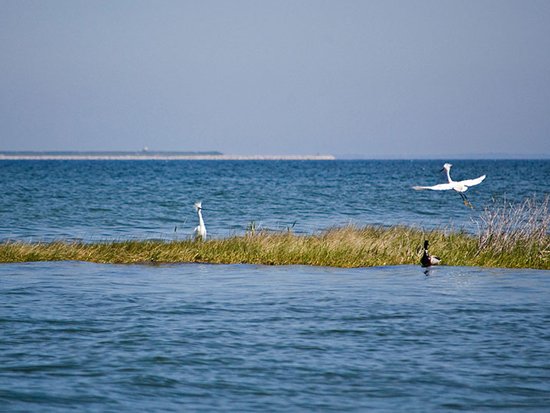
SENECA ROCKS, W.Va—At an event held Wednesday at the Seneca Rocks Discovery Center in Seneca Rocks, West Virginia, the National Fish and Wildlife Foundation (NFWF), U.S. Environmental Protection Agency (EPA) and the federal-state Chesapeake Bay Program announced over $9.4 million in grant awards to support water quality improvements, habitat restoration and community stewardship efforts in Maryland. The 27 grants announced will generate over $3.7 million in matching contributions for a total conservation impact of over $13.1 million.
The grants were awarded through the Small Watershed Grants (SWG) program, a key funding mechanism of the federal-state Chesapeake Bay Program designed to support projects within the Chesapeake Bay watershed that promote voluntary, community-based efforts to protect and restore the diverse and vital habitats of the Chesapeake Bay and its tributary rivers and streams. Major funding for these awards is provided by the U.S. Environmental Protection Agency, with additional support provided by the U.S. Department of Agriculture’s Natural Resources Conservation Service, U.S. Forest Service and Altria Group.
The SWG program is administered under NFWF’s Chesapeake Bay Stewardship Fund (CBSF), in partnership with the Chesapeake Bay Program and EPA. The CBSF is an ongoing 25-year partnership between NFWF and other federal and private funders that provides grant funding, technical assistance, networking and information sharing programming in support of local, on-the-ground conservation and restoration efforts to restore the Chesapeake Bay watershed.
“Today’s awards further NFWF’s long standing goals for advancing voluntary habitat and watershed restoration and conservation efforts across all 64,000 square miles of the Chesapeake Bay watershed, from the shores of the Chesapeake Bay in Maryland and Virginia to its headwaters streams and forests across Delaware, New York, Pennsylvania, and West Virginia,” said Jeff Trandahl, executive director and CEO of NFWF. “Through strategic investing, and by leveraging local on-the-ground conservation leadership and expertise, we’re demonstrating how efforts to help the Bay can provide real and meaningful value to local communities and stakeholders across the watershed.”
“Investments such as these are paramount to ensuring progress across the Bay and in all sectors,” said EPA Regional Administrator Adam Ortiz. “We are proud to work with our partners and fund these projects to make a difference in the restoration of the Bay watershed.”
Grant awards under the SWG program are an important mechanism to advance collective progress towards the commitments of Chesapeake Bay Program partners under the 2014 Chesapeake Bay Watershed Agreement through direct support for on-the-ground conservation and restoration efforts of nonprofit organizations, local governments, and their community partners. The new awards announced today will provide measurable contributions towards more than a dozen key partnership commitments for water quality improvement and healthy watersheds, community stewardship, forest buffers and urban tree canopy, oyster restoration, and restoration of stream and wetland habitats for brook trout, black duck, and migratory fish.
Some of this year’s Small Watershed Grant recipients in Maryland include:
- GreenTrust Alliance ($117,500) plans to advance the design and permitting of approximately 4,400 linear feet of living shoreline on rapidly retreating forested shoreline located on the western shore of the Chesapeake Bay in St. Mary’s County, Maryland. The project will advance efforts to implement a living shoreline along the Bay to protect riparian habitats and active aquaculture, while promoting sand accretion to eliminate the need to import sand.
- Gunpowder Valley Conservancy ($149,300) will deliver training to watershed restoration partners and conduct outreach to historically underserved communities and rural communities in the Gunpowder watershed. The project will develop a more inclusive Gunpowder watershed collaborative of organizations working together for clean water in the watershed and to create a list of diverse property owners who are willing to plant trees and install green infrastructure on their property.
- Maryland Association of Soil Conservation Districts ($318,500) will increase the adoption of conservation practices through the Farm Stewardship Certification program in Maryland. Project will offer new incentives for farmers and landowners, provide more effective and audience-specific outreach materials, and address emerging resource concerns such as soil health, urban agriculture and climate-smart agriculture, resulting in adoption of more than 7,000 acres of new agricultural conservation practices.
- Prince George’s County Government ($999,700) plans to restore more than 1,000 linear feet of a degraded, unhealthy tributary to Lower Beaverdam Creek, part of the Anacostia River watershed in Maryland. The project will mitigate streambank erosion, stabilize the stream channel, remove invasive riparian vegetation, improve water quality, and reduce nutrient and sediment pollution flowing downstream.
- Reid Temple African Methodist Episcopal Church ($54,700) will design green stormwater infrastructures to manage urban runoff at the Reid Temple African Methodist Church in Glenn Dale, Maryland. The project will add practices to the property with the goal of reducing, treating and managing impervious areas with pervious and porous green alternatives, increase erosion control and infiltration, improved aesthetics of the property, improved safety due to flooding and icing hazards, and improved mental health and well-being through green space access.
A complete list of the 2024 Chesapeake Bay Small Watershed Grants recipients is available here.
Since 1999, NFWF has awarded more than 1,300 grants through the Chesapeake Bay Stewardship Fund, totaling more than $248 million in funding to local, on-the-ground restoration and technical assistance projects, leveraged by more than $351 million in local matching resources.
For more information about the Chesapeake Bay Stewardship Fund or to download the 2024 Chesapeake Bay Small Watershed Grants Slates, visit www.nfwf.org/chesapeake.
About the National Fish and Wildlife Foundation
Chartered by Congress in 1984, NFWF protects and restores the nation’s fish, wildlife, plants and habitats. Working with federal, corporate, foundation and individual partners, NFWF has funded more than 6,800 organizations and generated a total conservation impact of more than $10 billion. NFWF is an equal opportunity provider. Learn more at nfwf.org.
About the U.S. Environmental Protection Agency Grants
Every year, EPA awards more than $4 billion in funding for grants and other assistance agreements. From small non-profit organizations to large state governments, the EPA works to help many visionary organizations achieve their environmental goals. With countless success stories over the years, EPA grants remain a chief tool to protect human health and the environment.
About the Chesapeake Bay Program
The Chesapeake Bay Program is a regional partnership consisting of federal, state and local governments, academic institutions and non-governmental organizations. Primarily funded by the U.S. Environmental Protection Agency, the Chesapeake Bay Program has set the guidance and policy for restoring the Chesapeake Bay since 1983. Learn more at www.chesapeakebay.net.















